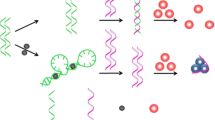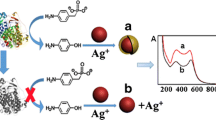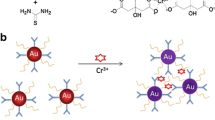Abstract
Dipicolinic acid (DPA) can cause neurotoxicity and is abundant in bacterial spores. Although analytical methods have been reported for DPA detection with high sensitivity, their selectivity toward DPA is declined greatly in the presence of phosphates in the samples. In this study, we developed an approach for DPA detection that is not affected by the presence of phosphates. A colorimetric method based on the use of gold nanoparticles (AuNP) complexed with Ca2+ as sensing agents was explored for DPA detection. Calcium ions and glutathione-capped gold nanoparticles (AuNPs@GSH) can easily form complexes (Ca2+-AuNP@GSH) through GSH-Ca2+ chelation, leading to the aggregation of AuNPs@GSH. The aggregation resulting from the complexes of AuNPs@GSH and Ca2+ can be reversed with the addition of DPA owing to the high formation constant (log Kf = 4.4) between DPA and Ca2+. Furthermore, the color of AuNPs@GSH changes from red to purple when complexed with Ca2+, returning to red upon addition of DPA. The limit of detection of this sensing method toward DPA was estimated to be as low as ~ 2 μM. The feasibility of using the sensing method for quantitative detection of DPA in soil and Bacillus cereus spore samples was also demonstrated.

A AuNP-based colorimetric sensing method against dipicolinic acid is developed.






Similar content being viewed by others
References
Maclean M, Murdoch LE, MacGregor SJ, Anderson JG. Sporicidal effects of high-intensity 405 nm visible light on endospore-forming bacteria. Photochem Photobiol. 2013;89(1):120–6.
Murrell W. Chemical composition of spores and spore structures. The bacterial spore. 1969;1:215–74.
Kort R, O'brien AC, Van Stokkum IH, Oomes SJ, Crielaard W, Hellingwerf KJ, et al. Assessment of heat resistance of bacterial spores from food product isolates by fluorescence monitoring of dipicolinic acid release. Appl Environ Microbiol. 2005;71(7):3556–64.
Janssen F, Lund A, Anderson L. Colorimetric assay for dipicolinic acid in bacterial spores. Science. 1958;127(3288):26–7.
Manoharan R, Ghiamati E, Dalterio R, Britton K, Nelson W, Sperry J. UV resonance Raman spectra of bacteria, bacterial spores, protoplasts and calcium dipicolinate. J Microbiol Methods. 1990;11(1):1–15.
Ghiamati E, Manoharan R, Nelson W, Sperry J. UV resonance Raman spectra of Bacillus spores. Appl Spectrosc. 1992;46(2):357–64.
Bell SE, Mackle JN, Sirimuthu NM. Quantitative surface-enhanced Raman spectroscopy of dipicolinic acid—towards rapid anthrax endospore detection. Analyst. 2005;130(4):545–9.
Grow AE, Wood LL, Claycomb JL, Thompson PA. New biochip technology for label-free detection of pathogens and their toxins. J Microbiol Methods. 2003;53(2):221–33.
Hupert N, Bearman GM, Mushlin AI, Callahan MA. Accuracy of screening for inhalational anthrax after a bioterrorist attack. Ann Inter Med. 2003;139(5_Part_1):337–45.
Goel AK. Anthrax: a disease of biowarfare and public health importance. World J Clin Cases. 2015;3(1):20.
Food, Administration D. Bad bug book: handbook of foodborne pathogenic microorganisms and natural toxins. Center for Food Safety and Applied Nutrition. 2012.
Foster A, Collins J, Schwarcz R. On the excitotoxic properties of quinolinic acid, 2,3-piperidine dicarboxylic acids and structurally related compounds. Neuropharmacology. 1983;22(12):1331–42.
Birley S, Collins J, Perkins M, Stone T. The effects of cyclic dicarboxylic acids on spontaneous and amino acid-evoked activity of rat cortical neurones. Br J Pharmacol. 1982;77(1):7–12.
Gopich IV, Szabo A. Theory of the energy transfer efficiency and fluorescence lifetime distribution in single-molecule FRET. Proc Nat Acad Sci. 2012;109(20):7747–52.
Schurr A, West CA, Rigor B. Neurotoxicity of quinolinic acid and its derivatives in hypoxic rat hippocampal slices. Brain Res. 1991;568(1):199–204.
Basile F, Zhang S, Shin Y-S, Drolet B. Atmospheric pressure-thermal desorption (AP-TD)/electrospray ionization-mass spectrometry for the rapid analysis of Bacillus spores. Analyst. 2010;135(4):797–803.
Warth A. Liquid chromatographic determination of dipicolinic acid from bacterial spores. Appl Environ Microbiol. 1979;38(6):1029–33.
Jarvis RM, Brooker A, Goodacre R. Surface-enhanced Raman scattering for the rapid discrimination of bacteria. Faraday Discuss. 2006;132:281–92.
Cowcher DP, Xu Y, Goodacre R. Portable, quantitative detection of Bacillus bacterial spores using surface-enhanced Raman scattering. Anal Chem. 2013;85(6):3297–302.
Cheung M, Lee WW, Cowcher DP, Goodacre R, Bell SE. SERS of meso-droplets supported on superhydrophobic wires allows exquisitely sensitive detection of dipicolinic acid, an anthrax biomarker, considerably below the infective dose. Chem Commun. 2016;52(64):9925–8.
Lewis J. Determination of dipicolinic acid in bacterial spores by ultraviolet spectrometry of the calcium chelate. Anal Biochem. 1967;19(2):327–37.
Hindle A, Hall EH. Dipicolinic acid (DPA) assay revisited and appraised for spore detection. Analyst. 1999;124(11):1599–604.
Nudelman R, Bronk B, Efrima S. Fluorescence emission derived from dipicolinic acid, its sodium, and its calcium salts. Appl Spectrosc. 2000;54(3):445–9.
Donmez M, Yilmaz MD, Kilbas B. Fluorescent detection of dipicolinic acid as a biomarker of bacterial spores using lanthanide-chelated gold nanoparticles. J Hazard Mater. 2017;324:593–8.
Gonçalves LCP, Da Silva SM, DeRose PC, Ando RA, Bastos EL. Beetroot-pigment-derived colorimetric sensor for detection of calcium dipicolinate in bacterial spores. PLoS One. 2013;8(9):e73701.
Clear KJ, Stroud S, Smith BD. Dual colorimetric and luminescent assay for dipicolinate, a biomarker of bacterial spores. Analyst. 2013;138(23):7079–82.
Shivakiran M, Venkataramana M, Rao PL. Rapid onsite detection of bacterial spores of biothreat importance by paper-based colorimetric method using erbium-pyrocatechol violet complex. Appl Microbiol Biotechnol. 2016;100(2):893.
Mocan T, Matea CT, Pop T, Mosteanu O, Buzoianu AD, Puia C, et al. Development of nanoparticle-based optical sensors for pathogenic bacterial detection. J Nanobiotechnol. 2017;15(1):25.
Zhang Y, Li B, Ma H, Zhang L, Zheng Y. Rapid and facile ratiometric detection of an anthrax biomarker by regulating energy transfer process in bio-metal-organic framework. Biosens Bioelectron. 2016;85:287–93.
Bhardwaj N, Bhardwaj S, Mehta J, Kim K-H, Deep A. Highly sensitive detection of dipicolinic acid with a water-dispersible terbium-metal organic framework. Biosens Bioelectron. 2016;86:799–804.
DaCosta MV, Doughan S, Han Y, Krull UJ. Lanthanide upconversion nanoparticles and applications in bioassays and bioimaging: a review. Anal Chim Acta. 2014;832:1–33.
Thibon A, Pierre VC. Principles of responsive lanthanide-based luminescent probes for cellular imaging. Anal Bioanal Chem. 2009;394(1):107–20.
Fell NF, Pellegrino PM, Gillespie JB. Mitigating phosphate interference in bacterial endospore detection by Tb dipicolinate photoluminescence. Anal Chim Acta. 2001;426(1):43–50.
Brandes Ammann A, Kölle L, Brandl H. Detection of bacterial endospores in soil by terbium fluorescence. Int. J. Microbiol. 2011;2011.
Pellegrino PM, Fell NF, Rosen DL, Gillespie JB. Bacterial endospore detection using terbium dipicolinate photoluminescence in the presence of chemical and biological materials. Anal Chem. 1998;70(9):1755–60.
Warth AD. Determination of dipicolinic acid in bacterial spores by derivative spectroscopy. Anal Biochem. 1983;130(2):502–5.
Lai H-Z, Wang S-G, Wu C-Y, Chen Y-C. Detection of Staphylococcus aureus by functional gold nanoparticle-based affinity surface-assisted laser desorption/ionization mass spectrometry. Anal Chem. 2015;87(4):2114–20.
Chai F, Wang C, Wang T, Li L, Su Z. Colorimetric detection of Pb2+ using glutathione functionalized gold nanoparticles. ACS Appl Mater Interfaces. 2010;2(5):1466–70.
Uddayasankar U, Krull UJ. Analytical performance of molecular beacons on surface immobilized gold nanoparticles of varying size and density. Analytica Chim. Acta. 2013;803:113–22.
Langer J, García I, Liz-Marzan LM. Real-time dynamic SERS detection of galectin using glycan-decorated gold nanoparticles. Faraday Discuss. 2017.
Sepúlveda B, Angelomé PC, Lechuga LM, Liz-Marzán LM. LSPR-based nanobiosensors. Nano Today. 2009;4(3):244–51.
Petryayeva E, Krull UJ. Localized surface plasmon resonance: nanostructures, bioassays and biosensing—a review. Analytica Chim Acta. 2011;706(1):8–24.
Chen J-Y, Chen Y-C. A label-free sensing method for phosphopeptides using two-layer gold nanoparticle-based localized surface plasma resonance spectroscopy. Anal Bioanal Chem. 2011;399(3):1173–80.
Lin H-Y, Chen C-T, Chen Y-C. Detection of phosphopeptides by localized surface plasma resonance of titania-coated gold nanoparticles immobilized on glass substrates. Anal Chem. 2006;78(19):6873–8.
Rodríguez-Lorenzo L, De La Rica R, Álvarez-Puebla RA, Liz-Marzán LM, Stevens MM. Plasmonic nanosensors with inverse sensitivity by means of enzyme-guided crystal growth. Nat Mater. 2012;11(7):604–7.
Hong X, Hall EA. Contribution of gold nanoparticles to the signal amplification in surface plasmon resonance. Analyst. 2012;137(20):4712–9.
Wu C, Xu Q-H. Stable and functionable mesoporous silica-coated gold nanorods as sensitive localized surface plasmon resonance (LSPR) nanosensors. Langmuir. 2009;25(16):9441–6.
Myroshnychenko V, Rodríguez-Fernández J, Pastoriza-Santos I, Funston AM, Novo C, Mulvaney P, et al. Modelling the optical response of gold nanoparticles. Chem Soc Rev. 2008;37(9):1792–805.
Kuo Y-L, Wang S-G, Wu C-Y, Lee K-C, Jao C-J, Chou S-H, et al. Functional gold nanoparticle-based antibacterial agents for nosocomial and antibiotic-resistant bacteria. Nanomedicine. 2016;11(19):2497–510.
Selvaprakash K, Chen Y-C. Detection of ricin by using gold nanoclusters functionalized with chicken egg white proteins as sensing probes. Biosens Bioelectron. 2017;92:410–6.
Liu Y, Li C, Liu Y, Tang Z. Helical silver (I)-glutathione biocoordination polymer nanofibres. Phil Trans R Soc London A. 2013;371(2000):20120307.
Baig MMF, Chen C-T, Chen Y-C. Photoluminescence determination of aluminum using glutathione-capped gold nanoclusters. Anal Lett. 2016;49(14):2246–58.
Liu J, Xia X, Li Y, Wang H, Li Z. Theoretical study on the interaction of glutathione with group IA (Li+, Na+, K+), IIA (Be2+, Mg2+, Ca2+), and IIIA (Al3+) metal cations. Struc Chem. 2013;24(1):251–61.
Li P-H, Lin J-Y, Chen C-T, Ciou W-R, Chan P-H, Luo L, et al. Using gold nanoclusters as selective luminescent probes for phosphate-containing metabolites. Anal Chem. 2012;84(13):5484–8.
Van Der Houwen J, Valsami-Jones E. The application of calcium phosphate precipitation chemistry to phosphorus recovery: the influence of organic ligands. Environ Technol. 2001;22(11):1325–35.
Christiansen T, Busch J, Krogh S. Successive determinations of calcium and magnesium in drinking water by complexometric, potentiometric digital titration to two equivalence points. Anal Chem. 1976;48(7):1051–6.
Katz AK, Glusker JP, Beebe SA, Bock CW. Calcium ion coordination: a comparison with that of beryllium, magnesium, and zinc. J Am Chem Soc. 1996;118(24):5752–63.
Kezia K, Lee J, Zisu B, Chen G, Gras S, Kentish S. Solubility of calcium phosphate in concentrated dairy effluent brines. J Agric Food Chem. 2017;65(20):4027–34.
Tajkarimi M. Bacillus cereus. Professional in Human Resources (PHR-250), University of California USA. 2007.
Knaysi G. Determination, by spodography, of the intracellular distribution of mineral matter throughout the life history of Bacillus cereus. J Bacteriol. 1961;82(4):556–63.
Kalle G, Khandekar P. Dipicolinic acid as a secondary metabolite in Penicillium citreoviride. J Biosci. 1983;5(1):43–52.
Lobodin VV, Juyal P, McKenna AM, Rodgers RP, Marshall AG. Tetramethylammonium hydroxide as a reagent for complex mixture analysis by negative ion electrospray ionization mass spectrometry. Anal Chem. 2013;85(16):7803–8.
Acknowledgements
We thank the Ministry of Science and Technology of Taiwan (MOST102-2113-M-009-019-MY3) for financial support of this research. MMFB thanks NCTU for providing him International Student Scholarship. We also thank Miss Ya-Ling Yang for her help in drawing the graphical abstract.
Author information
Authors and Affiliations
Corresponding author
Ethics declarations
Conflict of interest
The authors declare that they have no conflict of interest.
Electronic supplementary material
ESM 1
(PDF 1.08 mb).
Rights and permissions
About this article
Cite this article
Baig, M.M.F., Chen, YC. Gold nanoparticle-based colorimetric sensing of dipicolinic acid from complex samples. Anal Bioanal Chem 410, 1805–1815 (2018). https://doi.org/10.1007/s00216-017-0836-2
Received:
Revised:
Accepted:
Published:
Issue Date:
DOI: https://doi.org/10.1007/s00216-017-0836-2




